Introduction
fox Kitsune, the legendary fox spirits of Japan, are as mysterious as they are powerful. Known for their shapeshifting abilities and a reputation for mischief, they can shift into human form, cast illusions, and sometimes serve as divine messengers.
But Kitsune aren’t just tricky foxes; they’re complex spirits with their own morals and personalities, ranging from playful to protective or downright dangerous.
In Japanese folklore, Kitsune often represent duality. They’re wise, embodying both trickery and wisdom, depending on the situation.
In some tales, Kitsune act as benevolent guardians, guiding lost travelers or protecting families.
But in others, they delight in causing trouble, playing tricks on greedy or arrogant people. This spirit of duality makes Kitsune some of Japan’s most fascinating and beloved mythological creatures.
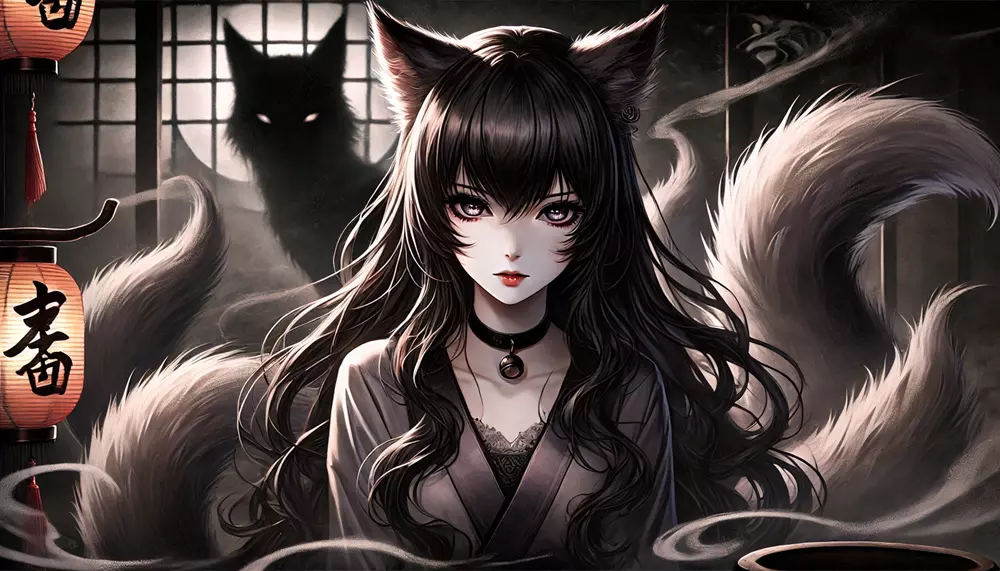
Kitsune have had an enduring impact on Japanese culture, appearing in art, literature, theater, and even modern pop culture. Today, they’re celebrated as both supernatural tricksters and guardians, reminding us that things aren’t always as they seem.
With their fox-like cunning and magical powers, Kitsune continue to captivate imaginations worldwide.
History & Origin
Kitsune legends date back centuries, with origins likely rooted in Japan’s relationship with foxes in the wild. As early as the Nara period (710–794 CE), people began associating foxes with supernatural powers.
By the time of the Heian period (794–1185 CE), Kitsune were well-established in Japanese folklore, gaining a reputation as shape-shifters and divine messengers. Early stories saw them as agents of the Shinto deity Inari, the god of rice and agriculture, who valued foxes as sacred beings.
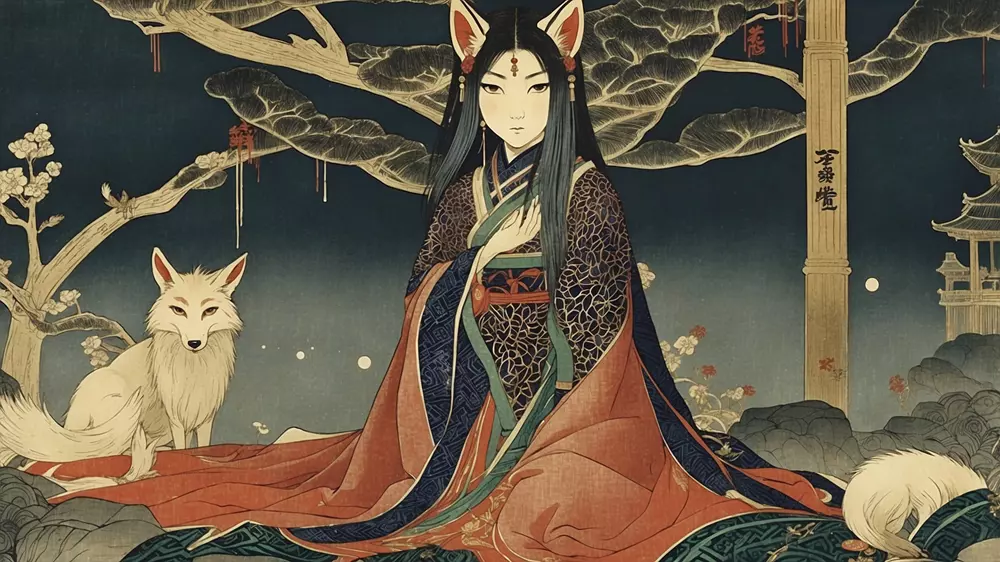
During Japan’s medieval period, Kitsune legends exploded in popularity. People saw foxes as creatures of wisdom, cunning, and sometimes danger.
They were said to live long lives, and with each century, a Kitsune would gain an extra tail, up to a maximum of nine, symbolizing immense power and knowledge.
The famous Konjaku Monogatari, a collection of Japanese folktales, contains multiple stories featuring Kitsune, often emphasizing their cleverness and ability to blend into human society by taking human forms.
As Japan entered the Edo period (1603-1868), Kitsune tales evolved further, reflecting society’s views on morality, honor, and the supernatural. Some stories warned against trusting strangers who seemed too perfect or too mysterious, as they might be Kitsune in disguise.
The legend of Tamamo-no-Mae, a nine-tailed Kitsune who posed as a beautiful woman to infiltrate the emperor’s court, became one of the most famous stories of a Kitsune using her powers for deceit. Over time, Kitsune went from being purely tricksters to more nuanced characters, embodying both wisdom and danger.
“The fox spirits known as Kitsune walk the line between trickery and wisdom, becoming as much revered as they are feared.” – Heian Folklore Archives
Name Meaning
“Kitsune” (狐) directly translates to “fox” in Japanese, but its meaning goes beyond the animal itself. The word has roots in ancient Japanese, capturing the creature’s dual role in folklore: both an ordinary fox and a supernatural entity.
Kitsune in folklore are believed to have a unique connection to the spirit world, and their name reflects that magical edge.
Kitsune with more spiritual connections are often referred to as “Myobu,” sacred foxes who serve the deity Inari. These divine foxes represent the higher, protective side of the Kitsune spirit, compared to the “Nogitsune,” or wild foxes, which are more likely to be tricksters or even malicious.
These categories highlight how Kitsune are more than just foxes, they’re symbols of duality and power, recognized in both their wild and sacred forms.
Different regions in Japan have their own variations of the name, each adding to the myth. In some stories, Kitsune are called “Osaki,” another term for fox spirit, used especially in areas with strong Inari worship.
These regional names show how deeply Kitsune are woven into the fabric of Japanese culture.
Background Story
One of the most famous Kitsune tales is the story of Tamamo-no-Mae, a nine-tailed fox spirit who used her beauty and intelligence to infiltrate the emperor’s court. Tamamo-no-Mae disguised herself as a stunningly beautiful woman, capturing the heart of the Japanese emperor.
But her true goal was far from romance, she wanted to weaken the emperor’s rule and bring chaos to Japan. She was eventually discovered and fled into the wilderness, but not before cementing her reputation as one of the most cunning Kitsune in Japanese lore.

In another popular story, a Kitsune falls in love with a human man and transforms into a woman to be with him. This story, known as The Grateful Foxes, is a tale of loyalty and sacrifice.
The Kitsune, taking human form, marries a man and lives happily with him for years, never revealing her true identity.
However, when the man discovers she’s a Kitsune, she leaves, unable to stay in the human world. Her departure is tragic, showing that Kitsune, even in love, remain bound to their supernatural nature.
Kitsune often appear in stories where they deceive or trick people, but their pranks can range from harmless to severe.
A Kitsune might disguise itself as a beautiful woman or an old friend, leading someone to confusion or even temporary insanity, which was once referred to as kitsune-tsuki, or “fox possession.” In these stories, Kitsune reflect the human experience of illusion and deception, teaching lessons about trust and wisdom.
“Beware the fox who wears a human’s face, for its eyes hold the glint of mischief and secrets.” – Japanese Folklore Collection
The Japanese folk tale The Farmer and the Kitsune presents a more benevolent side of Kitsune. In this story, a Kitsune transforms into a human woman and helps a poor farmer tend his fields, asking for nothing in return.
When the farmer discovers her true identity, he promises to keep her secret, and the Kitsune rewards him by blessing his land with fertility and abundance. This tale highlights the positive side of Kitsune as protectors and guides, contrasting with their trickster image.
Similar Beasts
Kitsune isn’t the only fox spirit out there. Across Asia, foxes have a reputation for their magical abilities.
In Chinese mythology, there’s the Huli Jing, a fox spirit that can be either malevolent or benevolent, similar to Kitsune. Like their Japanese cousins, Huli Jing can take human form, often appearing as beautiful women to seduce or trick people.
The tales of Huli Jing and Kitsune overlap a lot, with both beings sometimes viewed as divine messengers or dangerous tricksters.
Korea has its own fox spirit known as the Kumiho. Unlike Kitsune, Kumiho are usually depicted as more dangerous, often tricking men into death to consume their hearts or livers.
While Kitsune can be benevolent and protective, Kumiho legends emphasize their deadly nature.
This makes Kitsune unique because they’re as likely to help as they are to harm, depending on their mood or alignment with a deity like Inari.
In Western mythology, foxes don’t have the same mystical status, but they’re still considered clever, often appearing as tricksters in fables and folklore. A famous example is Reynard the Fox, a character in medieval European fables who uses cunning to outwit others, echoing Kitsune’s role as a clever, occasionally deceitful creature.
All these fox spirits share one thing in common: they embody the duality of charm and trickery.
Cultural Impact
Kitsune has left an unforgettable mark on Japanese culture, influencing everything from art and literature to everyday superstitions. You’ll find Kitsune statues outside Shinto shrines, especially those dedicated to Inari, where they guard the sacred space.
These statues often hold a symbolic item like a key or a jewel, showing their connection to divine knowledge and protection.
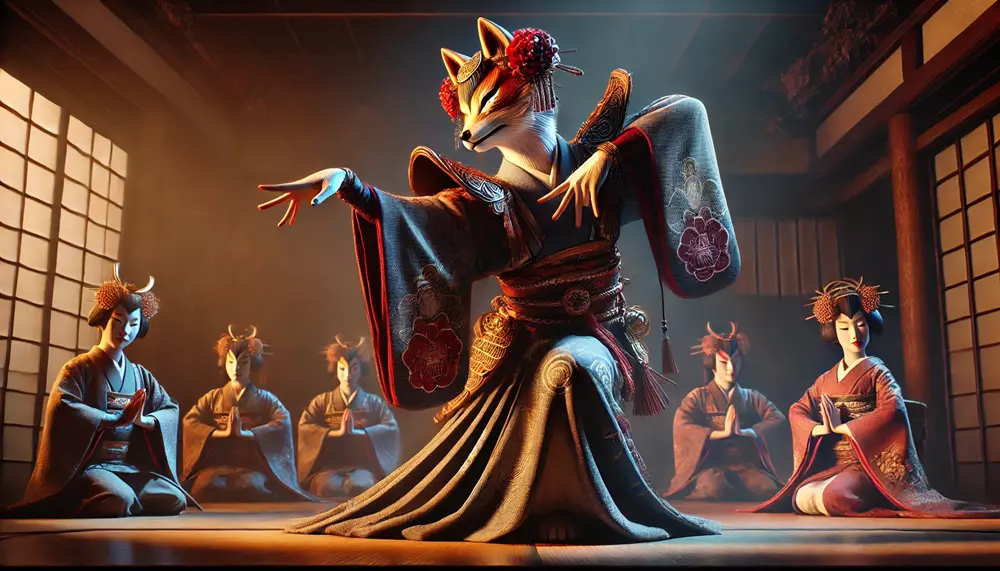
In theater, Kitsune have a special place in Kabuki, where actors bring their spirit to life through a traditional dance called kitsune-no-mai, or “the fox’s dance.”
This dance captures the grace and slyness of Kitsune, combining beauty with hints of their mysterious nature. Kitsune are also popular figures in Noh theater, where performers wear fox masks and enact legendary stories of transformation and trickery.

Modern pop culture has embraced Kitsune, too. They appear in anime, manga, and video games as characters who embody wit, wisdom, and supernatural power.
Popular series like Naruto and Natsume’s Book of Friends feature Kitsune-inspired characters that honor their folkloric roots. Kitsune continue to captivate because they bring something unexpected to each story, reminding audiences that beauty and danger often walk hand-in-hand.
“Kitsune statues guard our shrines, their eyes watching over all who seek Inari’s blessing.” – Inari Shrine Guide
Religion & Ritual
In Japanese Shinto practice, Kitsune hold a sacred status as messengers of the deity Inari. Inari shrines throughout Japan feature fox imagery, with Kitsune statues at their gates symbolizing guardianship.
People pray to Inari for blessings of prosperity, harvest, and protection, and Kitsune are seen as loyal protectors of these wishes. The foxes are known as Myobu, a title given to benevolent foxes serving the gods.
During the New Year and annual festivals, offerings of rice, sake, and fried tofu (aburaage) are left at Inari shrines. Fried tofu is a Kitsune favorite, according to folklore, and leaving this offering is thought to please the fox spirits and ensure their protection.
This connection to Inari has elevated Kitsune from mere tricksters to divine messengers, blending their spirit with Japan’s agricultural roots.
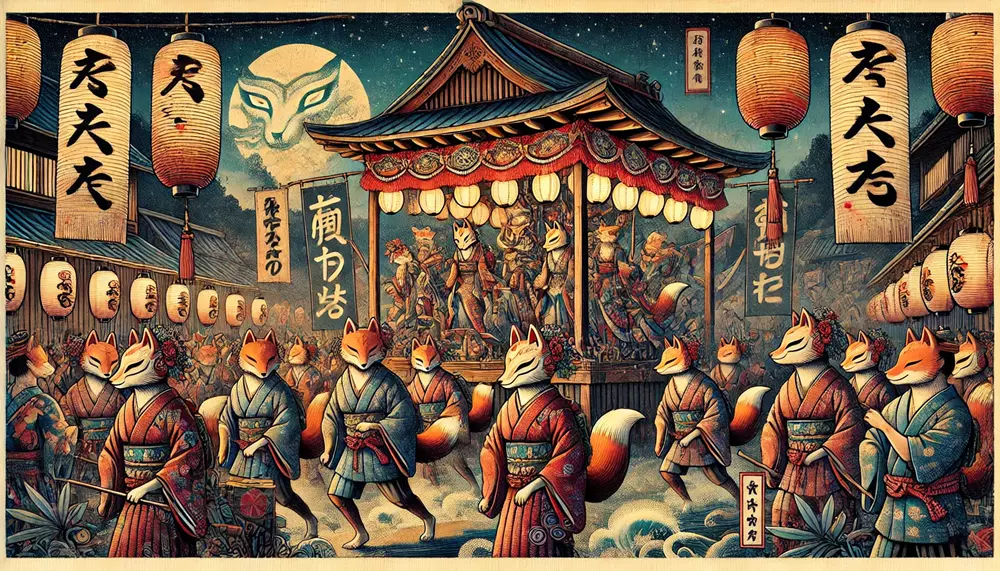
In some villages, special rituals called kitsune-matsuri (fox festivals) are held, celebrating the presence of Kitsune with dances, mask-wearing, and performances. These festivals honor both Inari and Kitsune, showcasing the people’s respect for the dual role of Kitsune as both mischievous spirits and benevolent guardians.
Scientific or Rational Explanations
Could there be a “real” reason behind the Kitsune legend? Some folklorists think Kitsune might have evolved from a mix of cultural beliefs and actual fox behavior.
Foxes are smart animals that often interact with human settlements, scavenging food and occasionally causing trouble. Early Japanese people may have noticed these behaviors and attributed them to supernatural qualities, imagining foxes as shape-shifters and tricksters.

Another theory is that Kitsune stories served as warnings. Kitsune’s ability to take human form, especially as beautiful women, could have been a cautionary tale against deception and overindulgence.
In a time when small villages had limited interaction with outsiders, a stranger with unusually charming looks might have aroused suspicion. The Kitsune legend could have reinforced values of caution and community trust.
Psychologists suggest that kitsune-tsuki, or “fox possession,” could be related to what we now know as dissociative identity disorder. Symptoms of kitsune-tsuki, where people claimed to be possessed by a Kitsune, mirror some characteristics of modern mental health conditions.
In the past, these behaviors might have been attributed to fox spirits, a way for people to rationalize unusual mental states.
In Modern Culture
Kitsune are everywhere in today’s pop culture, especially in Japan. They pop up in anime, manga, and video games as symbols of magic, wisdom, and sometimes playful mischief.
Take Naruto, where the main character is influenced by a nine-tailed fox spirit, or Pokémon, where the creature Ninetales is a clear nod to Kitsune folklore. These characters aren’t just references; they carry the legacy of Kitsune, with powers and personalities inspired by centuries-old tales.
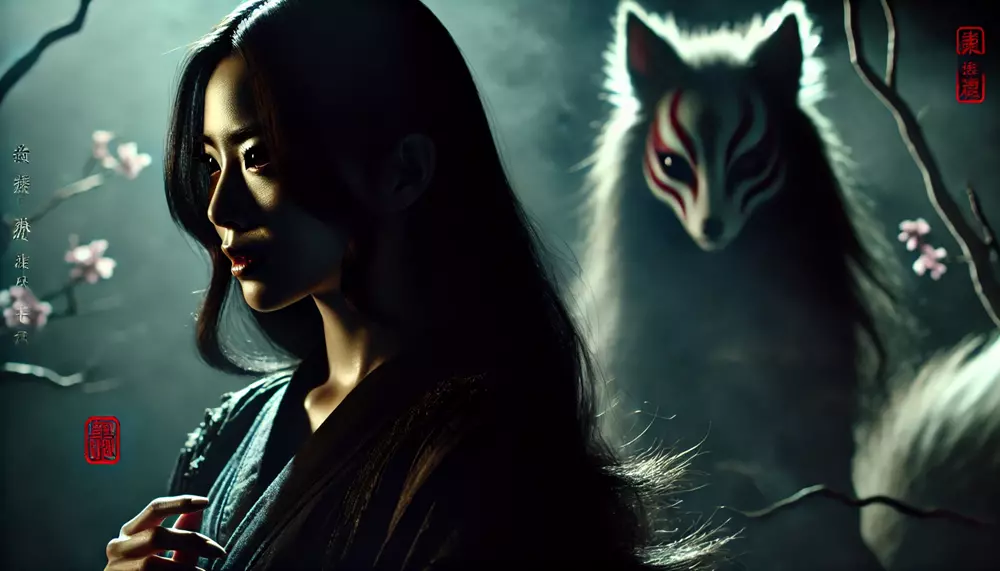
In Japanese horror films, Kitsune often appear as mysterious, otherworldly figures that can shift between human and fox forms. These portrayals usually highlight the darker side of Kitsune, like in the horror film Kwaidan, where a Kitsune appears as a beautiful woman with a hidden, dangerous side.
Kitsune are also referenced in novels like Neil Gaiman’s Sandman, showcasing how their appeal stretches beyond Japan.
Kitsune-themed merchandise is popular, too. From fox masks to plush toys, Kitsune symbols represent both protection and trickery.
Their imagery connects people to Japan’s mystical side, even in something as simple as a phone case or a keychain. Modern interpretations keep Kitsune’s myth alive, blending their folklore with contemporary storytelling.
“Kitsune continue to shape our stories, from ancient woodblock prints to animated series, enchanting new generations with their ageless charm.” – Japanese Pop Culture Analysis







